Carlsen survives almighty scare Caruana wins prelim stage
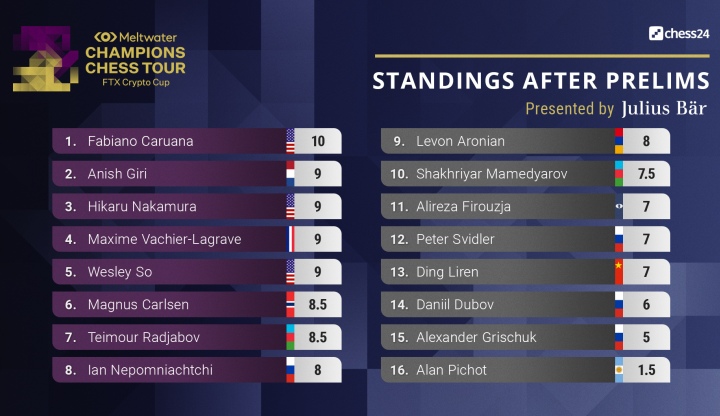
A frantic end to the FTX Crypto Cup’s prelim stage saw a surprise winner and Magnus Carlsen narrowly avoid being knocked early. The World Champion survived by the skin of his teeth as the three-day round-robin finished with Fabiano Caruana out on top. Caruana may be world number 2, but he is playing in his first Meltwater Champions Chess Tour event and was thought to have struggled to adapt to the rapid format. The American dispelled those myths immediately with a dominant 10/15 to sail into the knockout stage. However, the real surprise was Carlsen in serious danger of being knocked out at the first hurdle of a Tour event before pulling out a win when it mattered most. Carlsen got the vital point he needed to save the day in a nerve-jangling final round against Airthings Masters champ Teimour Radjabov. Anything less than a win would have meant Carlsen’s exit at the prelim stage for the first time since elite chess went online last year. The result meant heartbreak for Levon Aronian who had won his final game to pile even more pressure on Carlsen – but when it mattered most the champ held firm. “Obviously it’s a massive relief,” Carlsen said after. Tied for second behind Caruana were four players: Anish Giri, Hikaru Nakamura, Maxime Vachier-Lagrave and Wesley So all on 9/15. Radjabov finished level with Carlsen on 8.5, half a point ahead of this year’s World Championship challenger Ian Nepomniachtchi. Like his opponent in November, the Russian also had a rough ride and only just scraped into the top 8 at Aronian’s expense on a tiebreak. For further information, please contact: Leon Watson, PR for Play Magnus Groupleon@chessable.com+44 7786 078 770
R 04: Joy for the Muzychuks, but Elisabeth steals the show
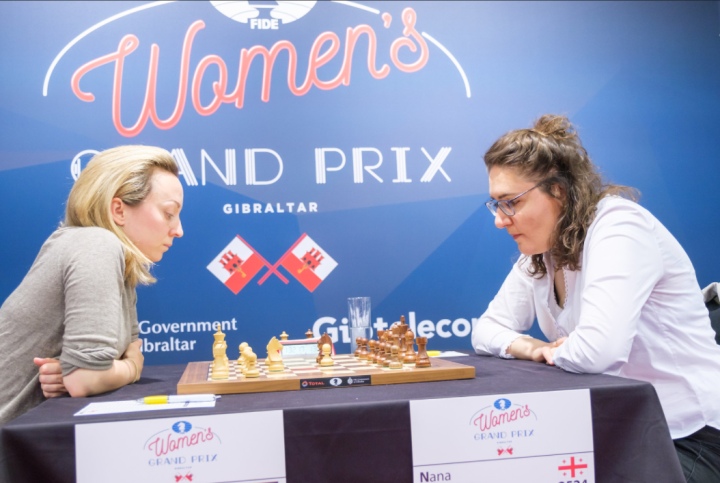
Three players share the lead after round four of the Gibraltar leg of the FIDE Women’s Grand Prix played at the Caleta Hotel on 25 May 2021. Zhansaya Abdumalik (Kazakhstan), Mariya Muzychuk (Ukraine) and Kateryna Lagno (Russia) have three points from a possible four, and they are also the only players in the field who remain unbeaten, such has been the uncompromising nature of the play. In fourth place is Elisabeth Paehtz (Germany) on 2½. Nana Dzagnidze of Georgia is one of the leading contenders to qualify from the Women’s Grand Prix for the Candidates’ competition, but her chances suffered a severe blow when she lost to Elisabeth Paehtz in what was the game of the day. Elisabeth played a c3 Sicilian which resulted in hanging pawns on c4 and d4. However, there was no obvious way to bring pressure to bear on what is usually seen as a weakness (but, in this case, wasn’t). Nana took four moves to relocate her knight from a6, where it had no prospects, to f6, where it might have more scope. However, allowing Elisabeth to swap a bishop for the knight on f6 and break up her kingside pawn structure proved disastrous. Elisabeth immediately launched her full force at the kingside and it was soon apparent that Black had little defence against the onslaught. Eventually, Nana had to give up her queen, plus two pawns, for two rooks, to prevent being mated but the cost was too high. With White’s king safely protected from rook checks, and Black’s opposite number exposed to an infinity of unpleasant checks, the outcome was never in doubt. A fine win for Elisabeth. Gunay Mammadzada of Azerbaijan has established a reputation for brinkmanship and enterprise in this tournament so far but she came unstuck against former world champion Mariya Muzychuk. After 18 moves of solid Sveshnikov Sicilian theory, Mariya went into a side-line with 18…Bd7, though the first new move was her 20…f5, following a pawn sacrifice for some activity Gunay’s play in an imbalanced and complex position seemed reasonable enough until she went seriously wrong with 25.b4, after which her position collapsed with alarming rapidity. It was a great round for the Muzychuk sisters as Mariya’s sister Anna also secured a full point in the longest game of the day against Valentina Gunina of Russia. Anna chose an offbeat and innocuous line against Valentina’s Caro-Kann. Anna was of the opinion that she was slightly worse in the early middle game until Valentina embarked on a three-move excursion with her queen, during which time the position equalised and then swung in favour of Anna by virtue of her control over the d-file. Though a little short of time, Anna maintained her grip until the time control, steadily outplaying her opponent from that point on. A knight ending morphed into a queen and knight ending as both players queened pawns but by now Anna had worked out a continuation through to victory. Irina Bulmaga’s game with round three co-leader Zhansaya Abdumalik was another Sveshnikov Sicilian and had some point of interest. But, after the queens came off, despite an imbalanced pawn structure, neither player found enough scope to merit playing on beyond move 30. Antoaneta Stefanova and Kateryna Lagno headed into an unpromising side-line of the Grünfeld, which resulted in massive exchanges and a sterile rook and pawn endgame after 30 moves. Dinara Saduakassova, playing White, was content to end her run of losses with an early draw against Alina Kashlinskaya in a line of the English which ended with a three-move repetition. Standings after Round 4: 1-2. Zhansaya Abdumalik, Kateryna Lagno, Mariya Muzychuk – 3; 4. Elisabeth Paehtz – 2½; 5-8. Gunay Mammadzada, Nana Dzagnidze, Anna Muzychuk, Antoaneta Stefanova – 2; 9-10. Irina Bulmaga, Alina Kashlinskaya – 1½; 11. Valentina Gunina – 1; 12. Dinara Saduakassova – 1/2. Text: John Saunders Photo: John Saunders and David Llada
FIDE expands support program for distinguished veterans
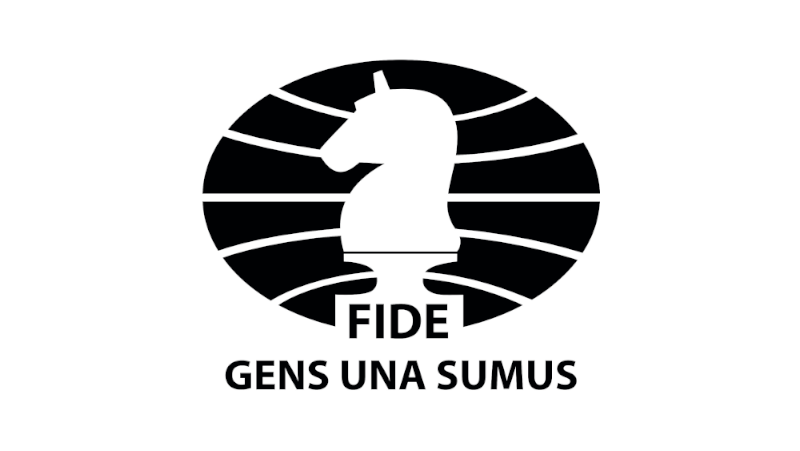
Dear Member Federations: The International Chess Federation is pleased to announce the expansion of its support program to distinguished chess veterans in 2021. Following the 12 grants that have been already distributed earlier this year, another 12 will be awarded in June. Players, coaches, and organizers aged 65+, who have contributed to the development of chess and who are in an unstable financial situation, are eligible to submit an application. We invite federations, clubs, and players themselves to send their applications, including a CV of the nominee, to the FIDE Secretariat: office@fide.com. The deadline for submissions is June 10, 2021. In 2020, FIDE allocated to this program an initial sum of €35.000, which was later expanded with an additional €21.000. Combined, this amounted to a total of €56.000, a record since FIDE launched this program in 2013. In 2021, €30.000 have already been distributed, and a similar sum has been allocated for this new batch of grants.
Round 3: Players go all-in
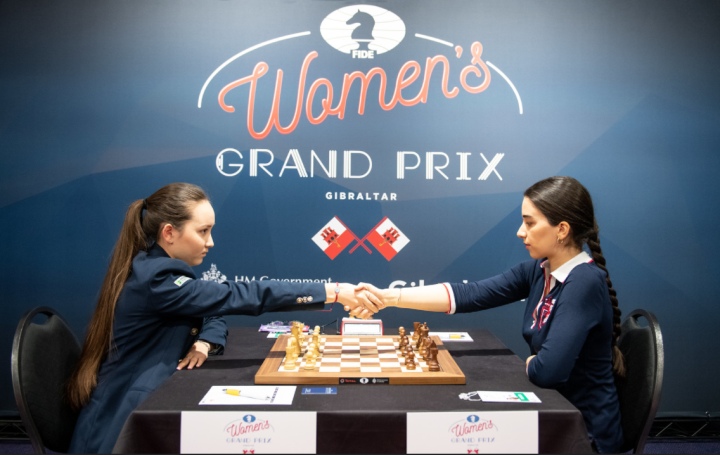
The lead after round three of the Gibraltar leg of the FIDE Women’s Grand Prix, played at the Caleta Hotel on 24 May 2021, is shared by two players: overnight leader Zhansaya Abdumalik (Kazakhstan) drew with Gunay Mammadzada (Azerbaijan) to make her score 2½ out of 3, while Kateryna Lagno won an all-Russian clash against Valentina Gunina to reach the same score. Three players, Gunay Mammadzada, Mariya Muzychuk (Ukraine) and Nana Dzagnidze (Georgia) are a further half-point behind, after another round of uncompromising chess which produced four decisive encounters and two hard-fought draws which lasted well into the second session. Everyone went all-in today: this is exactly the sort of chess we’ve been missing during the pandemic. There was much interest in the meeting of the two players born in the year 2000, leader Zhansaya Abdumalik and Gunay Mammadzada who is just half a point behind her. Despite their youth, they have already been rivals for many years, having first met in the World Girls’ Under 8 Championship in 2008. Today they proceeded down a familiar line of Semi-Slav Meran theory until about move 16, when Gunay, playing Black, gradually assumed the initiative as White proved to have wasted time with 13. Ng5. Zhansaya, not wanting to succumb meekly, lashed out with a dramatic piece sacrifice, 21.Bxh6. Capturing it was possible, and seemed to find favour with engines, but the advantage of doing so is not obvious to the human eye as the resultant position only looks slightly better for Black. Gunay opted to retain more options but Zhansaya defended tenaciously. The game remained horribly complicated right up to the time control, with Gunay running her clock down to one second remaining before playing her 39th move. Still, she retained an edge which led to winning a pawn. However, that wasn’t the end of the story as she was unable to find a way past Zhansaya’s determined defence. A draw after a splendid fight, which reflected well on both players. Alina Kashlinskaya had a nightmare start to the tournament, but fate smiled upon her last against Anna Muzychuk as the Ukrainian played into some of the Russian’s Classical Nimzo-Indian opening preparation. The consequence of 12…d4 and the subsequent exchange (for a pawn) sacrifice on d1 had all been carefully stress-tested in the Kashlinskaya/Wojtaszek opening laboratory before being inflicted on Anna. It meant leaving the white king in the center, but Alina was able to develop her rook via h3 and g3 and increase the pressure on Black’s king. Anna tried to blunt the attack by offering the exchange back but White simply emerged a pawn up to the good. Black tried to counter with an attack but Alina, after checking and double-checking her calculations (for fear of blowing another won position), mounted a final assault on Anna’s king. There’s still plenty of time to recover but this put a severe dent in Anna Muzychuk’s chances of challenging for a Candidates’ place. Nana Dzagnidze and Dinara Saduakassova opened with a line of the English in which the queens disappear as early as move 8. Dinara’s new move 9…b6 steered the game away from a line disputed by Levon Aronian and Maxime Vachier-Lagrave a couple of times. Though even for much of its course, the pawns were imbalanced on both sides of the board and it became a battle to see who could squeeze the most positional juice out of the structure in Magnus Carlsen style. During the post-game interview, Nana said she felt confident about her chances of exploiting her well-placed kingside pawns. That said, had Dinara played 33…Bd7, Nana wasn’t entirely sure of the way to take advantage of her extra kingside pawn (with Black’s extra queenside pawn having few prospects of undoubling). Thereafter Black soon succumbed. Elisabeth Paehtz versus Mariya Muzychuk was another Classical Nimzo-Indian, with Elisabeth as Black obtaining some early pressure against White’s d-pawn. Mariya’s reaction 15.Nh4 looked quite outlandish, but it proved its worth subsequently as she gained some compensation for the pawn. Indeed, White soon became the player with an extra pawn herself. However, it came down to a queen endgame in which White was unable to make real progress. Another draw and a real fight, albeit less entertaining for the spectators than the Abdumalik-Mammadzada confrontation. Valentina Gunina played an unusual line against Kateryna Lagno’s choice of King’s Indian Defence… at least, that’s what I thought until I checked a database and discovered that a good number of modern GMs, including Ian Nepomniachtchi, have been experimenting with these very same ideas.. (I suppose it goes to show that my own concept of what is usual in this defence is about fifty years out of date.) But I wasn’t impressed and neither, evidently, was Kateryna Lagno as she secured a comfortable, flexible black set-up quite quickly. More seriously, Valentina played 18.b4 rather too quickly and Kateryna exploited this with 19…Ra3 with a lateral attack along the rank. White’s 20.e5 worsened the situation and Valentina had to give up a knight in return for a pawn on the seventh and some tactical tricks. Kateryna proceeded to defuse all the tricks and cashed in her extra material to win, thus moving alongside Zhansaya as co-leader. Irina Bulmaga against Antoaneta Stefanova began life as a Scotch Opening. With the queens off and the pawns balanced on either side, a draw seemed the likeliest prospect, and remained so for much of the game, though both players strove to be positive and try to win. Irina, with White, seemed to preserve what little advantage there was as a result of having her king nearer the kingside action. Consequently, Black’s moves were a little harder to find. Eventually, Antoaneta went astray, according to analysis engines, on move 55 when 55…Kd7 would have kept her within sight of a draw, while everything else lost. But it looks like a desperately hard ‘only move’ for a human to work out, so Antoaneta will be too experienced and phlegmatic to reproach herself for missing it. A very fine win for Irina, who told us later that she had never won a classical game against Antoaneta previously. Standings after Round
FIDE announces qualification paths for Candidates Tournament 2022
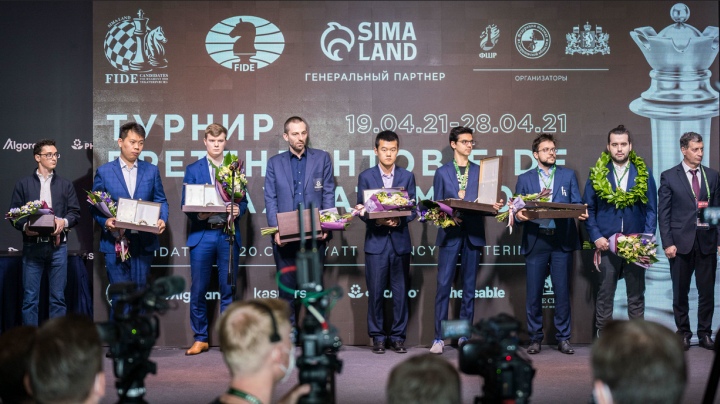
The International Chess Federation has approved the qualification criteria to select the eight players who will participate in the Candidates Tournament 2022. Like in the previous cycle, the goal has been to devise a democratic qualification system, where every reasonably strong player is given a chance to qualify. These are the different qualifying events and criteria: A) One spot – FIDE World Championship Match 2021, Runner-up As tradition goes, one spot will go directly to the runner-up at the FIDE World Championship Match, to be played in Dubai (UAE) in November-December 2021. B) One spot – GM Teimour Radjabov (winner of the FIDE World Cup 2019) One place will be reserved for Teimour Radjabov, the winner of the FIDE World Cup 2019. FIDE President Arkady Dvorkovich mentioned that this was his intention in a recent interview. The FIDE Council members fully supported his position, so we are happy to confirm that Teimour will be granted this possibility. C) Two spots – FIDE World Cup 2021 Two spots will be decided at the FIDE World Cup 2021, to be played in Sochi (Russia), in July-August 2021. The two finalists in this event will earn their tickets to the Candidates 2022. It may happen that Teimour Radjabov or any of the two contenders in the 2021 match (Magnus Carlsen or Ian Nepomniachtchi) are in the final. In this case, the place will be passed on to the next non-qualified player in the FIDE World Cup (but not further than 4th place) or to the next non-qualified player in the FIDE Grand Prix Series 2022. D) Two spots – FIDE Chess.com Grand Swiss Tournament 2021 Two places will be at stake in the FIDE Chess.com Grand Swiss Tournament 2021, to be held in October-November 2021 in Douglas (Isle of Man). The two top-finishers in this 114-player event, which is expected to be the strongest Swiss event ever held, will advance to the next stage of the world championship cycle 2021-2022. If any of these two players happen to be already qualified through events A, B or C, the spot will go to the next non-qualifying player in the standings of the FIDE Chess.com Grand Swiss Tournament 2021. E) Two spots – FIDE Grand Prix Series 2022 The remaining two spots will be granted to the two top-finishers at the FIDE Grand Prix Series 2022, which will take place between February and April 2022. The Regulations for the Series will be published in June. We must note that the winner of the FIDE World Championship Match 2021 is not allowed to participate in Grand Prix Series. Likewise, none of the players already qualified via events A, B, C or D, is expected to take part in the Grand Prix. If any of them decides to participate, they should give up their qualification spot previously earned. In the eventuality of any schedule modification caused by the pandemic or any other force majeure circumstances, the FIDE Council is entitled to adjust the qualification criteria accordingly.
FIDE Online Cadets & Youth Rapid World Cup 2021 announced

The FIDE Online Rapid World Cup (Cadets & Youth 10-18) is a two-stage tournament that will be played in 5 different age groups – under 10, 12, 14, 16, 18, and 2 sections – open and girls (totally 10 tournaments). The participants must not have reached their 10th, 12th, 14th, 16th, 18th birthday, respectively, before January 1st of the year 2021. Qualifying Stage (August 1 – 20, 2021) Every Chess Federation can register 3 (three) players per category in the qualifying stage (30 players in total) which is held in the format of 10-round Swiss tournament. In some cases, the federations are entitled to replace players from various age categories, boys and girls, within 30 players. According to the “medal statistics” of 2017 – 2020, some federations can register additional players. Federations are entitled to apply to the organizer for the wild cards during the registration process. Final stage (August 26 – 31, 2021) The finals will consist of ten separate 16-player KO tournaments (Girls under 10, 12, 14, 16, 18 and Open under 10, 12, 14, 16, and 18) with 6 players who have personal right to participated and 10 qualifiers in each, 160 participants in total. Three top-finishers per category will qualify for the FIDE Online Rapid Super Final 2021. The prize fund of Super Final amounts to €30,000. The players placed 4-8 (5 players) and one highest-rated player (by 01.08.2021 Fide Standard rating) among 9-16th places in the World Cup 2021 per category in each qualifying tournament will advance to the FIDE Online Rapid Grand Prix Series 2021. Registration deadline is July 10th, 22:00 CET, 2021. World Cup will be played on Tornelo platform. You can find all the information related to World Cup information on the tournament official website https://youth-worldcup.fide.com/ CONTACT INFORMATION Email address: youth@fide.com Additional Quota for Federations based on World Cadets & Youth Medal Statistics (2017 – 2020) FEDERATION Points Gold Points Silver Points Bronze Number of Playersallowed to participate 1 USA 99 36 21 156 2 RUS 72 54 27 153 3 IND 72 30 18 120 4 CHN 45 42 12 99 5 KAZ 9 24 9 42 6 ARM 9 12 3 24 7 UZB 0 18 6 24 8 POL 0 12 9 21 9 GER 18 0 0 18 10 IRAN 9 6 3 18 11 AZE 9 6 0 15 12 MGL 9 0 6 15 13 UKR 0 12 0 12 14 INA 9 0 3 12 15 HUN 0 12 0 12 16 NED 9 0 0 9 17 UAE 9 0 0 9 18 ESP 9 0 0 9 19 GEO 0 6 3 9 20 PER 9 0 0 9 21 SVK 9 0 0 9 22 SLO 9 0 0 9 23 CZE 0 6 0 6 24 PUR 0 0 3 3 25 SRB 0 0 3 3 26 ECU 0 0 3 3 27 VIE 0 0 3 3 28 COL 0 0 3 3 29 ITA 0 0 3 3 414 276 138 828 1 Gold = 9 points 1 Silver = 6 points 1 Bronze = 3 points
FIDE Chessable Academy: 140 Nominations from 51 Federations

Dear member Federations: At the close of the official deadline, the newly created FIDE Chessable Academy has received 140 nominations from 51 Federations to enrol their most promising young talents into this training program. Eligible players are between the ages of 8 and 16. This is the breakdown by country: No Country Boys Girls Total Africa 1 Botswana 1 1 2 2 Gambia 1 1 2 3 Senegal 1 1 2 4 Uganda 1 1 2 America 5 Argentina 2 1 3 6 Barbados 1 1 2 7 Brazil 1 1 2 8 Canada 1 1 2 9 Chile 2 1 3 10 Cuba 1 1 2 11 Jamaica 1 1 2 12 Panama 1 1 2 13 Paraguay 1 1 2 14 Trinidad & Tobago 1 1 2 15 USA 3 3 6 Asia 16 Chinese Taipei 1 1 2 17 India 8 4 12 18 Japan 1 1 2 19 Jordan 1 1 2 20 Kazakhstan 1 3 4 21 Kyrgyzstan 1 1 2 22 Malaysia 1 1 2 23 New Zealand 1 1 2 24 Palestine 1 1 2 25 Singapore 1 1 2 26 Sri Lanka 1 1 2 27 Syria 1 0 1 Europe 28 Albania 1 1 2 29 Andorra 1 1 2 30 Belgium 2 1 3 31 Bulgaria 2 2 4 32 Cyprus 1 1 2 33 Czech Republic 1 1 2 34 England 1 1 2 35 France 3 2 5 36 Germany 1 1 2 37 Greece 1 1 2 38 Italy 1 1 2 39 Ireland 1 1 2 40 Latvia 1 1 2 41 Moldova 1 1 2 42 Nederlands 1 2 3 43 Poland 1 3 4 44 Romania 1 1 2 45 Russia 4 8 12 46 Scotland 1 1 2 47 Spain 1 1 2 48 Sweden 1 1 2 49 Turkey 2 1 3 50 Ukraine 2 1 3 51 Wales 1 1 2 There have also been many requests to allow for extra time to contact candidates and especially due to this coinciding with the start of several FIDE World Cup continental qualifying events. Therefore, FIDE agreed to extend the deadline to the end of Tuesday, May 25, by 17:00 CET.
Round 2: Blood on Board
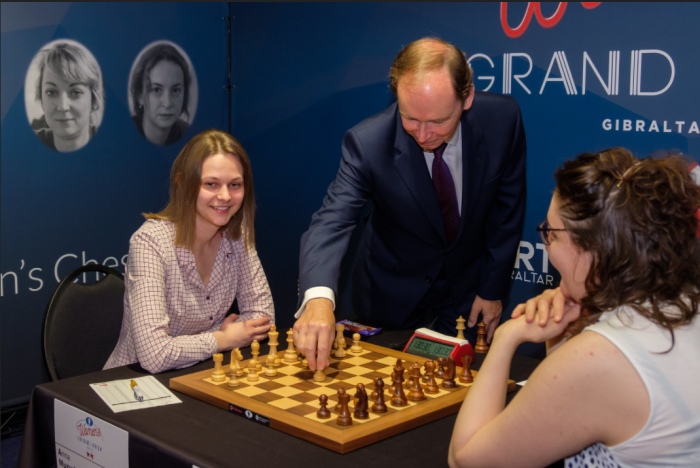
Zhansaya Abdumalik, 21-year-old IM from Kazakhstan, is the sole leader on two points after round two of the Gibraltar leg of the FIDE Women’s Grand Prix was played at the Caleta Hotel on 23 May 2021. There are four players on 1½ points: Gunay Mammadzada (Azerbaijan), Mariya Muzychuk (Ukraine), Kateryna Lagno (Russia) and Antoaneta Stefanova (Bulgaria). The round was opened by the Governor of Gibraltar, His Excellency Sir David Steel, who expressed his gratitude to the players. “Thank you for coming so far to play in this magnificent tournament. Chess and Gibraltar go hand in hand: not quite as much, perhaps, as chess and Russia, chess and Azerbaijan, chess in Bulgaria, but quite close – we’re catching up. And you have come to Gibraltar at a time when Gibraltar is opening up after the pandemic and you have come, some of you a very long way, to be here.” Today we were also pleased to welcome back the founder and long-time organiser of the Gibraltar Chess Festival, Mr. Brian Callaghan, without whose untiring efforts major tournament chess would never have established a home in Gibraltar. The first result of the day was a draw between Anna Muzychuk and Nana Dzagnidze. This was an interesting skirmish in the Sveshnikov Sicilian, with the first decision of significance occurring on move 14 when Anna opted for 14 g4 to keep an eye on the light squares. Some cagey maneuvers followed, as two of the highest-rated players in the field jockeyed for superiority. The players safely neutralized each other’s attempts to win and by the time the queens were exchanged, the draw was in view. Thereafter there were terrifying quantities of blood spilled on the board, with no fewer than three players suffering a second defeat in two games. All five remaining games ended decisively, though, as in Round 1, not all ended in the result as first expected. Kateryna Lagno put herself in great danger of defeat as she unaccountably retreated her queen to its original square on move 12 on the white side of a Petroff defense, allowing a slow squeeze to be applied by Alina Kashlinskaya. It seemed improbable that Kateryna would get out of jail, but, as in round one, all Alina’s initial success went for naught as she snatched a hot pawn on the queenside, only to be shocked by Kateryna’s 21.Nxg7, underpinned by a sneaky tactic that would have won Black’s had the knight been captured. As a result, Black had to live with an ugly gash in her kingside pawn capture. Having blown a won position the day before against her other Russian colleague, poor Alina must have been suffering déjà vu and quickly subsided. Elisabeth Paehtz and Zhansaya Abdumalik went into round two with a win apiece but it was the young Kazakhstani player who proceeded to a perfect 2/2 start with another assured performance. The game began with an offbeat line of the Ruy Lopez (Berlin). Zhansaya’s original development of her a8 rook, via a6 to b6 to f6, and subtly undermining White’s queenside pawn structure, impressed commentator Nigel Short, and no doubt many others. Black snagged a pawn and deftly nursed her material and positional advantage through to another victory. One is beginning to wonder whether Zhansaya might have made a breakthrough in standard during the lull caused by the global pandemic, much as Aleksandra Goryachkina did a year or two back. Gunay Mammadzada versus Irina Bulmaga was some sort of indeterminate Sicilian which I would hesitate to give a more specific name to. Nor am I sure I’m qualified to give an opinion on who had the advantage out of the opening, despite having the inestimable advantage of hearing Gunay’s enthusiastic demonstration of the game at close quarters in the media center. Gunay seemed to relish the cut and thrust of the ensuing battle as both players descended into serious time trouble with only seconds left on their clocks. “It was more like a bullet game, then,” I observed to her and she agreed. Unsurprisingly, engines signalled wild swings of fortune during the period between move 23 and the time control. Black missed one golden opportunity with 26…Rh6 and once again the engine informs us that 33…Kb8 was a killer. Gunay herself felt sure without the benefit of engine analysis that 38…Qb5 represented another move that might have won for Black. Sadly for her, Irina missed all of these shots, and yet I cannot be sorry as otherwise I wouldn’t have been treated to Gunay’s entertaining exposition of this encounter. The game between Dinara Saduakassova and Mariya Muzychuk was a Catalan which followed a game between Deac and Gavrilescu from the Romanian Championship less than a month ago for some 15 moves, which I guess makes it a hot theory. It could also be described as one of those unusual Queen’s Gambits where Black hangs on grimly to the gambit pawn. Instructional manuals always used to be full of such games where Black is punished for such greediness, but whatever positional compensation Dinara gained for the pawn never quite materialized. Perhaps things mightn’t have been so bad had not Dinara retreated her knight to the a1 square where it looked decidedly unhappy. She then made the decision to hoover off the rooks to leave a most unpromising knight endgame, and she soon succumbed. The final game to finish was a slightly old-fashioned Caro-Kann between Antoaneta Stefanova and Valentina Gunina. Though Valentina professed to have “slept like a baby” the night before after her earlier travel woes, perhaps they caught up with her in round two. Things started getting interesting around move 18 or 19, as it became a question of whether the black bishop on b7 could exploit the white squares around White’s exposed king or whether White’s two bishops might cooperate to harass Black’s vulnerable kingside. A few moves down the line, Black’s choice of 21…g6 looked unhealthy on the long black diagonal. White even had the luxury of snaffling the b5-pawn. Talking about it afterwards, Antoaneta Stefanova felt confident of ultimate success once she had engineered a queen exchange. Just before the
12 chess gems by the 12th World Champion
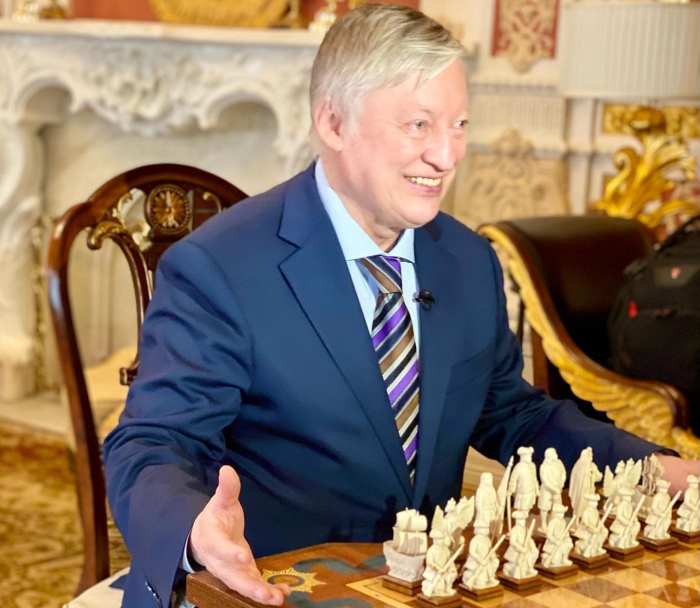
Anatoly Karpov is celebrating his 70th anniversary. The entire chess world congratulates the legendary champion. To mark this occasion we handpicked 12 fragments, 12 chess gems created by Anatoly Yevgenyevich throughout his long and rewarding career. Karpov – Kortschnoj (Moscow, 1974) 24. e5!! It is extremely important block up the fifth rank. 24.Nxf6? exf6 25.Nh5 Qg5! was a false trail. 24…Bxd5 25. exf6 exf6 26. Qxh7+ Kf8 27. Qh8+ (27…Ke7 28. Nxd5+ Qxd5 29. Re1+) 1-0 Karpov – Czom (Bad Lauterberg, 1977) One may think that White is in great trouble, as the h7-square is protected, but Karpov went for this position foreseeing a deadly blow 50. Nf5!! (50… Nxd7 51. Qh2+ Kg8 52. Qg3+ Kf7 53.Qg7#) 1-0 Karpov – Quinteros (Buenos Aires, 1980) 32. f5! White breaks through in the most fortified point. 32… Rxh7 (32… exf5 33. Bxf5) 33. fxg6+ Kg8 (33… Kxg6 34. Bxe6+ Qg5 35. Nf4#) 34. gxh7+ Kh8 35. Nf4 1-0 Karpov – Geller (Moscow, 1981) 31. Rxf7!! Black has to go with the tide. 31…Kxf7 32. Qxg6+ Kf8 33. Qxh6+ [33. Qxh6+ Ke8 (33… Kg8 34. Qh7+Kf8 35. Qh8+ Ke7 36. Qg7+ Ke8 37. Bg6#) 34. Bb5+] 1-0 Karpov – Miles (London, 1982) Black’s position looks OK, as White’s is a6-pawn is cut off from the rest of the army, but 29. Rxd5! Rxd5 30. Rc3! Rd8 31. Rc7! (but not 31.Bg2? Rd4 32.a7 d5) Rd1 32. Bxb5 e5 33. a7 exf4 34. Rb7 Rb1+ 35. Ka4 Rxb5 36. Rxb5 f3 37. Rb8 f2 38. Rxd8+ 1-0 Karpov – Sax (Linares, 1983) White executes Black’s king using geometrical motifs: 35. Re7!! Rd1+ 36. Kxd1 Qxe7 37. Qa8+ Kc7 38. Qa7+ Kd6 39. Qb6+ 1-0 Karpov – Jussupow (Moscow, 1983) Black is threatening with a highly unpleasant discovered attack Rg3+. Karpov found a simple and elegant solution. 43. Rh2!! The queen will be protected, the game is over 43…Qd7+ 44. f5 1-0 Karpov – Gurevich (Reggio Emilia, 1991) 77. Qh8+ Bh6 78. Qe5+!! Deflection in its purest form! [78…Qxe5 79.g4#] 1-0 Karpov – Shirov (Biel, 1992) Karpov carried out an instructive attack over the light squares. 29. Qg4! Qc6 (29… Rxa7 30. Qe6+) 30. Rxb7 Qxb7 31. Qe6+ Kh8 32. Be4 (32…Qa6 33.Ng6+ Kh7 34.Ne5+ Kh8 35.Nf7+ Kg8 36. Nh6+ Kh8 37.Qg8+ Rg8 38.Nf7#) 1-0 Karpov – Salov (Linares, 1993) 33. Qxg6! (33… hxg6 34. Rh4) 1-0 Karpov – Morovic Fernandez (Las Palmas, 1994) 32. Rh8+! Kxh8 33. Qh1+ Kg8 34. Bxf6 Qxg3+ 35. fxg3 Re2+ 36. Kh3 gxf6 37. Kg4 1-0 Karpov – Topalov (Dos Hermanas, 1994) 30. Nf6!! Combining the ideas of decoying and discovered attack. 30…Kxf6 (30… Qxf3 31. Nxe8+) 31. Be5+! Kxe5 32. Qxe4+ Kxe4 33. Re1+ Kf5 34. Rxe8 Be6 35. Rxf8 Bxa2 36. Rc8 1-0
Round 1: Opening Salvoes

Round 1 of the Gibraltar leg of the FIDE Women’s Grand Prix got underway at the Caleta Hotel on 22 May 2021. Thankfully, all players were present for the start, with Valentina Gunina of Russia being the last to arrive just a few hours before the round started at 3 pm local time. Opening proceedings with a short address was Dana Reizniece-Ozola, managing director of FIDE. Dana holds the woman grandmaster title and herself took part in the 2010 Gibraltar Masters, later embarking on a career in politics and administration in her native Latvia. Dana made the ceremonial first move for Gunnay Mammadzada (Azerbaijan) against former women’s world champion Antoaneta Stefanova of Bulgaria. The first game to finish concluded in around half an hour as sisters Anna and Mariya Muzychuk agreed to a draw. They played a sprightly line of an Anti-Marshall Ruy Lopez/Spanish opening with Black (Anna) giving up her queen to launch a minor piece assault on the white king. However, it is all been seen before and leads to a draw by perpetual check. Nana Dzagnidze and Kateryna Lagno played down a lengthy theoretical variation in the Fianchetto Grünfeld. The pawn structure remained balanced, and pieces were exchanged, until the queenside pawns disappeared completely after which a draw seemed inevitable. Gunay Mammadzada is perhaps a lesser known name in Western Europe, though she has played in Gibraltar once before. She lives in Baku (or ‘Chess City’ as she referred to it after her game) and will turn 21 a few days after the tournament. She found herself facing the redoubtable former women’s world champion Antoaneta Stefanova who has played in Gibraltar many times before and captains the women’s team in the annual Battle of the Sexes match held at the festival. Gunay was unfazed by her opponent’s reputation and embarked on a long line of Ruy Lopez/Spanish theory. The position had some interest but when a repetition presented itself, the players decided to split a point. So far, three draws, but the watching audience was richly rewarded with some entertainment in the three remaining games, all of which resulted in decisive though not in the way that had seemed likely earlier in the games, at least in two cases. As has already been mentioned, Valentina Gunina was the player to arrive in Gibraltar, after a trying journey from Russia and with only a few hours to compose herself for this important game. To be honest, it looked like it as she subsided into a poor position. Her compatriot Alina Kashlinskaya looked almost certain to win. Valentina found herself forced to surrender the exchange just to maintain some semblance of a chance. But then fortune suddenly changed: an injudicious 27.f4, attacking a knight, was countered by a clever 27…d3 intermezzo move which gave Valentina some strong play against Alina’s weak kingside structure. Still, the great wheel of fortune hadn’t yet turned completely, but a further mistake (34.h3) allowed Valentina’s small commando force to run riot on the dark squares, stymieing White’s hopes of capitalising on her advanced passed pawn and threatening mate. Alina could do nothing and Valentina found herself with what in all the circumstances was the most improbable of full points. She could hardly believe it when interviewed, pronouncing herself “tired and lucky”. Zhansaya Abdumalik and Dinara Saduakassova fought a well-contested game which we were surprised to learn was only the second time these talented players from Kazakhstan had ever met over the board at classical chess. It took a while to catch fire after a steady Giuoco Piano opening, but then a tricky phase of play allowed Zhansaya to gain the advantage of an outside passed pawn. It didn’t look fatal by any means in the early stages, but it was impressive to see how the 21-year-old exploited and increased this positional edge against her 25-year-old rival. The last game of the day to finish, after four and a half hours’ play was between Irina Bulmaga of Roumania and Elisabeth Paehtz of Germany. The opening was a full-blooded Najdorf Sicilian so the audience could expect a real fight from the start. When Irina’s pawn roller started to advance on Lizzie’s king down the kingside, one started to fear for the German IM’s chances. All the more so when White’s attack the weak spot at f7 more times than it could be defended. The black king was obliged to flee towards the middle of the board, where it would surely have perished but Irina made a disastrous mistake 38.Nd2??, which allowed Lizzie to threaten mate on b2. The black king was still an open target to White’s remaining group of pieces, but none of them could land a fatal blow or even secure a perpetual check. Lizzie’s first words after the game: “I’ve aged 100 years today.” A tough day indeed, but wonderful entertainment for the audience and a great start for the event. Standings after Round 1: 1-3. Zhansaya Abdumalik, Valentina Gunina, Elisabeth Paehtz – 1; 4-9. Gunay Mammadzada, Mariya Muzychuk, Nana Dzagnidze, Kateryna Lagno, Anna Muzychuk, Antoaneta Stefanova – ½; 9-12. Irina Bulmaga, Alina Kashlinskaya, Dinara Saduakassova – 0. Text: John Saunders Photo: John Saunders and David Llada

